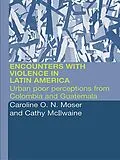Latin America is both the world's most urbanized fastest developing regions, where the links between social exclusion, inequality and violence are clearly visible. The banal, ubiquitous nature of drug crime, robbery, gang and intra-family violence destabilizes countries' economies and harms their people and social structures.
Encounters with Violence & Crime in Latin America explores the meaning of violence and insecurity in nine towns and cities in Columbia and Guatemala to create a framework of how and why daily violence takes place at the community level. It uses pioneering new methods of participatory urban appraisal to ask local people about their own perceptions of violence as mediated by family, gender, ethnicity and age. It develops a typology which distinguishes between the political, social, and economic violence that afflicts communities, and which assesses the costs of consequences of violence in terms of community cohesion and social capital. This gives voice to those whose daily lives and dominated by widespread aggression, and provides important new insights for researchers and policy-makers.
Autorentext
Cathy McIlwaine, Caroline Moser
Inhalt
List of figures. List of tables. 1. Urban violence as a contested domain 2. Toward a policy-relevant positioning of violence: the role of participatory research methodologies 3. The multiple complexity of daily violence in urban Colombian and Guatemalan communities 4. Community perceptions of the structural factors underlying political and economic violence 5. The family as a violent institution and the primary site of social violence 6. Substance abuse-linked violence relating to drug and alcohol consumption 7. Organized violence at the community level 8. Violence, social institutions and social capital in communities 9. Avoiding or confronting violence? Community perceptions of strategies and solutions Appendices. Notes. Bibliography. Index.
